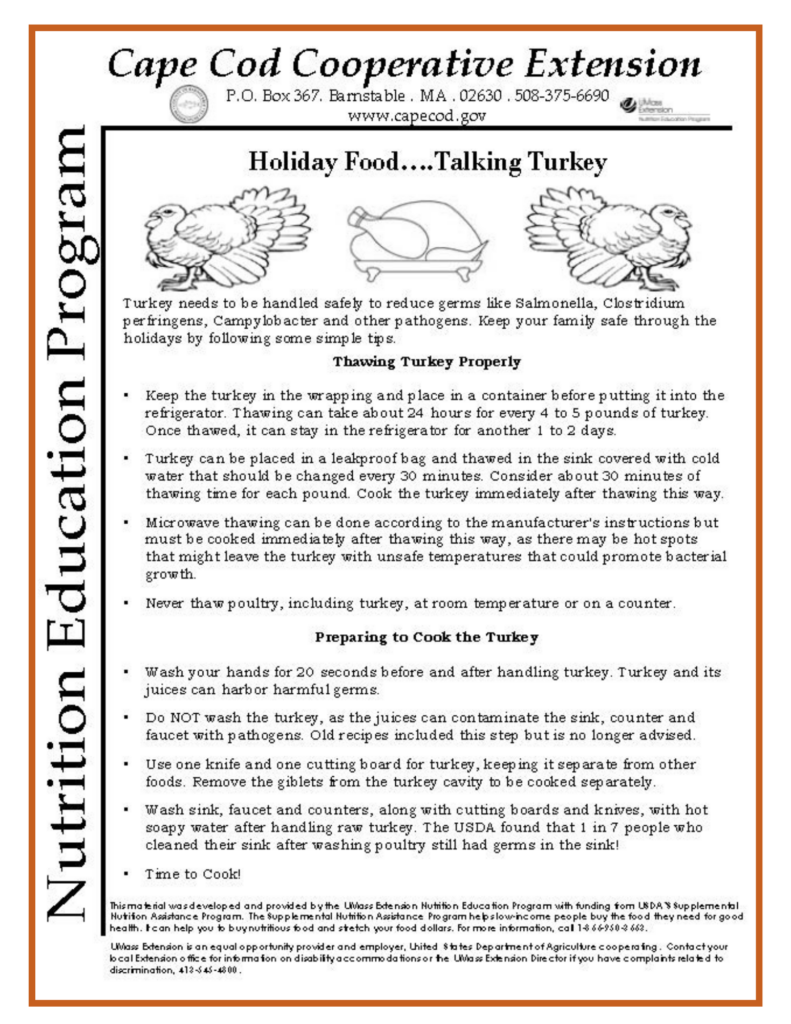
Holiday Turkey Talk
~A note from Kim Concra, LDN, Extension’s Nutrition and Food Safety Educator
Turkey needs to be handled safely to reduce scary sounding germs like Salmonella, Clostridium, perfringens, Campylobacter and other pathogens. Keep your family safe through the holidays by following some simple tips.
Thawing Turkey Properly
- Keep the turkey in the wrapping and place in a container before putting it into the refrigerator. Thawing can take about 24 hours for every 4 to 5 pounds of turkey. Once thawed, it can stay in the refrigerator for another 1 to 2 days.
- Turkey can be placed in a leakproof bag and thawed in the sink covered with cold water that should be changed every 30 minutes. Consider about 30 minutes of thawing time for each pound. Cook the turkey immediately after thawing this way.
- Microwave thawing can be done according to the manufacturer’s instructions but must be cooked immediately after thawing this way, as there may be hot spots that might leave the turkey with unsafe temperatures that could promote bacterial growth.
- Never thaw poultry, including turkey, at room temperature or on a counter.
Preparing to Cook the Turkey
- Wash your hands for 20 seconds before and after handling turkey. Turkey and its juices can harbor harmful germs.
- Do NOT wash the turkey, as the juices can contaminate the sink, counter and faucet with pathogens. Old recipes included this step but is no longer advised.
- Use one knife and one cutting board for turkey, keeping it separate from other foods. Remove the giblets from the turkey cavity to be cooked separately.
- Wash sink, faucet and counters, along with cutting boards and knives, with hot soapy water after handling raw turkey. The USDA found that 1 in 7 people who cleaned their sink after washing poultry still had germs in the sink!
- Time to Cook!
Stuffing
Stuffing is best cooked separately in a casserole dish and should be cooked to 165 degrees. If you do put stuffing in the turkey, do this right before cooking. Cooked this way, the stuffing needs to reach 165 degrees and should be left in the turkey for another 20 minutes to allow it to cook a bit longer. Roasting a turkey should start in an oven with a temperature of at least 325 degrees, placed in a pan that is a couple of inches deep. It can take about 15-20 minutes per pound, but all parts need to reach at least 165 degrees to reduce the risk of any pathogens. Let the turkey rest for another 20 minutes before cutting into it.
Frozen or partially frozen turkey may take another 50% longer to cook than a thawed turkey. Raw turkey cut into smaller sections may be covered and cooked in the microwave, but all parts must reach 165 degrees. Allow the turkey to rest to be sure all parts are cooked well.
Temperature Check
Insert a food thermometer into the thick part of the breast, the thigh, and where the body and wing join, aiming towards the wing. All parts need to reach at least 165 degrees. Allow to rest 20 minutes before carving into the turkey.
If the turkey has a pop-up timer, you still must use a food thermometer!
Safe Handling of Ready-Prepared Turkey Dinners
If picked up or delivered hot, the food must be kept at least 135 degrees. If not eaten within 2 hours, remove stuffing from the cavity of a whole turkey and refrigerate, cutting the turkey into smaller manageable portions. Reheat to 165 degrees.
If picked up or delivered cold, promptly refrigerate and reheat portions to 165 degrees before eating. Reheating a whole bird is not recommended.
(Adapted from Turkey from Farm to Table | Food Safety and Inspection Service (usda.gov).
Leftovers
Refrigerate all meal leftovers, including turkey, to 41 degrees or lower within 2 hours of cooking to prevent food poisoning. If exposed to high temps 90 degrees or higher, refrigerate in one hour. Clostridium perfringens is a common foodborne illness that occurs during holiday season and can result in major abdominal cramps and vomiting within 6 to 24 hours of eating.
Reheat all leftover cooked turkey and soups or other foods made with it, to 165 degrees. Eat leftovers within 3-4 days or freeze leftovers in tightly sealed containers to keep them longer.

If you have any questions about food safety, recipes, and cooking tips, feel free to reach out to me at kconcra@capecod.gov or check out Extension’s nutrition website at www.capecod.gov/nutrition.




